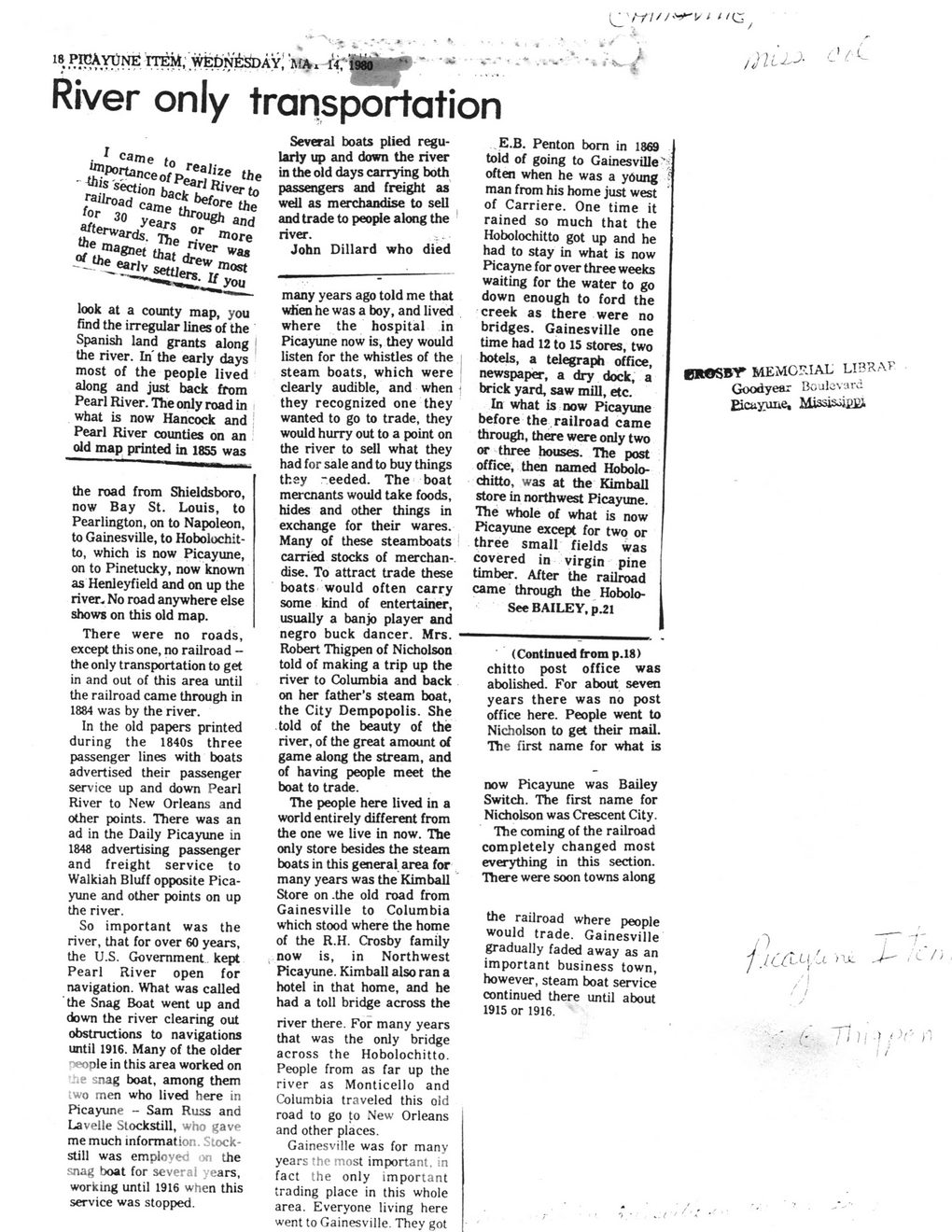This text was obtained via automated optical character recognition.
It has not been edited and may therefore contain several errors.
18 PlCAYtTNE ITEiA; 'wfebjpStoAV! M** rt," River only transportation Jo ^PoTnLofP^ the '*«'section backhi, Ver to railroad cam.l 0re 0,6 for 30 a"d afterwards T?e J m°« the magnet that h was -*-*«uia£vs look at a county map, you find the irregular lines of the Spanish land grants along the river. In' the early days most of the people lived along and just back from Pearl River. The only road in what is now Hancock and , Pearl River counties on an old map printed in 1855 was the road from Shieldsboro, now Bay St. Louis, to Pearlington, on to Napoleon, to Gainesville, to Hobolochit-to, which is now Picayune, on to Pinetucky, now known as Henleyfield and on up the river* No road anywhere else shows on this old map. There were no roads, except this one, no railroad -the only transportation to get in and out of this area until the railroad came through in 1884 was by the river. In the old papers printed during the 1840s three passenger lines with boats advertised their passenger service up and down Pearl River to New Orleans and other points. There was an ad in the Daily Picayune in 1848 advertising passenger and freight service to Walkiah Bluff opposite Picayune and other points on up the river. So important was the river, that for over 60 years, the U.S. Government kept Pearl River open for navigation. What was called the Snag Boat went up and down the river clearing out obstructions to navigations until 1916. Many of the older >*oDle in this area worked on •tie :nag boat, among them two men who lived here in Picayune - Sam Russ and Lavelle Stockstill, who gave me much information. Stockstill was employed on the snag boat for several years, working until 1916 when this service was stopped. Several boats plied regularly up and down the river in the old days carrying both passengers and freight as well as merchandise to sell and trade to people along the ■ river. John Dillard who died many years ago told me that when he was a boy, and lived where the hospital in Picayune now is, they would listen for the whistles of the steam boats, which were dearly audible, and when -j they recognized one they wanted to go to trade, they would hurry out to a point on the river to sell what they had for sale and to buy things they -eeded. The boat mercnants would take foods, hides and other things in exchange for their wares. Many of these steamboats carried stocks of merchandise. To attract trade these boats would often carry some kind of entertainer, usually a banjo player and negro buck dancer. Mrs. ■ Robert Thigpen of Nicholson told of making a trip up the river to Columbia and back on her father’s steam boat, the City Dempopolis. She told of the beauty of the river, of the great amount of game along the stream, and of having people meet the boat to trade. The people here lived in a world entirely different from the one we live in now. The only store besides the steam boats in this general area for many years was the Kimball Store on .the old road from Gainesville to Columbia which stood where the home of the R.H. Crosby family now is, in Northwest Picayune. Kimball also ran a hotel in that home, and he had a toll bridge across the river there. For many years that was the only bridge across the Hobolochitto. People from as far up the river as Monticello and Columbia traveled this oid road to go to New Orleans and other places. Gainesville was for many years the most important, in fact the only important trading place in this whole area. Everyone living here went to Gainesville. They got E.B. Penton born in 1869 told of going to Gainesville" often when he was a young man from his home just west of Carriere. One time it rained so much that the Hobolochitto got up and he had to stay in what is now Picayne for over three weeks waiting for the water to go down enough to ford the creek as there were no bridges. Gainesville one time had 12 to 15 stores, two hotels, a telegraph office, newspaper, a dry dock, a brick yard, saw mill, etc. In what is now Picayune before the railroad came through, there were only two or three houses. The post office, then named Hobolochitto, was at the Kimball store in northwest Picayune. , The whole of what is now Picayune except for two or three small fields was covered in virgin pine timber. After the railroad came through the Hobolo-See BAILEY, p.21 (Continued from p.18) chitto post office was abolished. For about seven years there was no post office here. People went to Nicholson to get their mail. The first name for what is now Picayune was Bailey Switch. The first name for Nicholson was Crescent City. The coming of the railroad completely changed most everything in this section. There were soon towns along the railroad where people would trade. Gainesville gradually faded away as an important business town, however, steam boat service continued there until about 1915 or 1916. fJROSBy MEMORIAL LI3RAF Goodyear Boulevard Cicu^uiie, Missis^y^ n (■ j l )\-} I /

BSL 1977 To 1980 Pearl-River-Only-Transportation